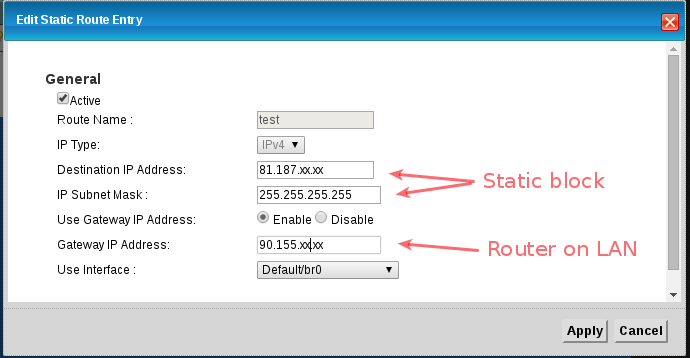VMG1312-B10A: Static Routes: Difference between revisions
mNo edit summary |
mNo edit summary |
||
| Line 14: | Line 14: | ||
[[File:ZyXEL-staticroute.png|frame|none|The new Static route, as shown on the routes page]] |
[[File:ZyXEL-staticroute.png|frame|none|The new Static route, as shown on the routes page]] |
||
==Firewall== |
|||
It seems that the firewall will be unaware of the static route, and adding firewall entries to allow the traffic will be ignored. Disabling the firewall will allow the traffic through the ZyXEL to your router. This is normally required anyway, as customers would typically use the firewall features on the internal router. |
|||
==CLI== |
==CLI== |
||
Revision as of 13:27, 16 June 2015
Static routes can be applied manually. This allows a second block of IP addresses allocated by AAISP to be routed to a router on your LAN on the inside of the ZyXEL router, eg
INTERNET <--> ZyXEL <--> ROUTER <--> LAN
(Note, some people may prefer to set the ZyxEL to Bridge mode, and then have your own Router use PPP to log in. This has the advantage of keeping the ZyXEL config simpler and giving your own router more control over the Internet access.)
The static route can be added via the web interface:
Network Setting -> Routing -> Add new static route
Here is an example:


Firewall
It seems that the firewall will be unaware of the static route, and adding firewall entries to allow the traffic will be ignored. Disabling the firewall will allow the traffic through the ZyXEL to your router. This is normally required anyway, as customers would typically use the firewall features on the internal router.
CLI
From the CLI (telnet/SSH) you can view the route table with:
route show
The list should display immediately, if there are pauses between showing the default routes and the new static then this could be an indication of a problem with DNS look-ups and should not affect the actual routing.